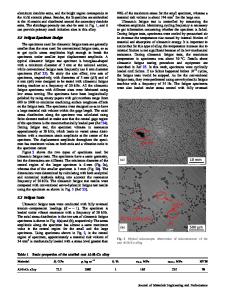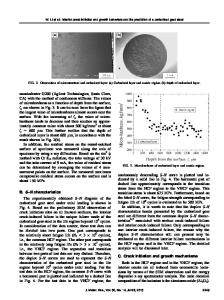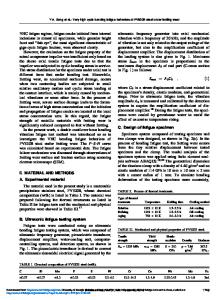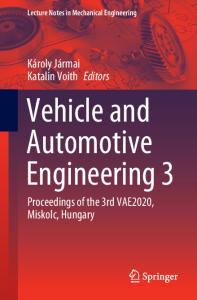Crack initiation in the very high cycle fatigue regime of nitrided 42CrMo4 steel
- PDF / 659,180 Bytes
- 12 Pages / 584.957 x 782.986 pts Page_size
- 69 Downloads / 391 Views
Surface treatments such as shot peening, deep rolling, or nitriding are known to be very effective for the protection of a surface against fatigue crack initiation, due to surface hardening and residual compressive stresses introduced below the surface. Thus, crack initiation of cyclically loaded materials occurs predominantly at internal nonmetallic inclusions (NMIs). Two different plasma-nitriding treatments were performed on a quenched and tempered 42CrMo4 cast steel. Ultrasonic fatigue tests were performed up to 109 cycles. Resonant frequency and the nonlinearity parameter were recorded in situ during the fatigue tests. Fractographic analyses were performed by means of scanning electron microscopy in combination with energy-dispersive X-ray spectroscopy. The results showed that nitriding, as expected, led to improvements in both fatigue life and rates of internal crack initiation at NMIs. However, the analysis of in situ parameters revealed that internal crack initiation occurred at stress amplitude levels well below the failure stress amplitude even for repeated loading until the run-out limit of 109 cycles.
I. INTRODUCTION
Since the end of the 1990s, it has been well known that fatigue failure can occur even at stress amplitudes well below the classical fatigue limit observed in the high cycle fatigue (HCF) regime of 106 # Nf # 107.1–5 At that time, new experimental techniques are developed that allowed fatigue testing at higher frequencies of up to 1000 Hz (servo-hydraulic machine6) or 20 kHz (ultrasonic fatigue testing, see e.g., Ref. 7). Using these new techniques, it is possible to test materials up to a number of cycles well above 107. The results of these investigations show that even at low stress amplitudes, fatigue failure can occur due to both surface as well as internal crack initiation,1–5,8,9 resulting in a multistage shape stress amplitude versus number of cycles to the failure curve (S–N curve). In some cases, a second fatigue limit is observed in the very high cycle fatigue (VHCF) regime (Nf $ 107). In addition, these investigations reported that crack initiation typically occurs at the surface in both low cycle fatigue (LCF) and HCF regimes, and that internal crack initiation occurs in the bulk material in the VHCF regime. However, internal crack initiation accompanied by fisheye formation is also observed in the HCF regime for case-hardened steels, where surface crack initiation is avoided due to residual compressive stresses below the surface.8 According to Mughrabi,10 metallic materials can be divided into two main classes with respect to their fatigue Contributing Editor: Gary L. Messing a) Address all correspondence to this author. e-mail: [email protected] DOI: 10.1557/jmr.2017.308
behavior in the VHCF regime: (i) type I materials, which are pure ductile (annealed) materials and (ii) type II materials, which are steels or materials containing discontinuities such as nonmetallic inclusions (NMIs), dispersoids, particles, or pores. Both type I and type II materials exhibit multis
Data Loading...











